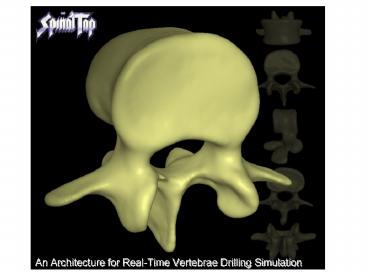An Architecture for RealTime Vertebrae Drilling Simulation PowerPoint PPT Presentation
Title: An Architecture for RealTime Vertebrae Drilling Simulation
1
An Architecture for Real-Time Vertebrae Drilling
Simulation
2
Virtual WHAT?
- When a patient ruptures a disc, it has to be
removed and the surrounding vertebrae are fused
together using a piece of bone - Pedicle screws are inserted into the vertebrae
to stabilize it during fusion
Pictures from www.spine-health.com
3
Why simulate this?
- Pedicle screw insertion is inherently dangerous,
so its difficult to get experience - Training options are poor
- Simulation is cheap!
Haptic drill may in fact not be cheap
4
How to simulate Spinal Drilling
- Make a Virtual Vertebrae
- Make a Virtual Drill
- Virtually Drill the Virtual Drill into the
Virtual Vertebrae - (Its virtually that simple)
5
Step 2 A Virtual Drill
- Only the drill bit actually drills
- The drill bit is a cylinder with a conical end
cap - we ignore the threads on the drill bit
6
Step 3 Virtual Drilling
- General problem We have a volume we want to
decimate with our Virtual Drill Bit - General Solution Fill the volume with volume
elements and throw them away when they
intersect with the Virtual Drill Bit
7
A note about speed
- We are using haptic feedback devices
- Need high feedback rates (300Hz-10000Hz)
- This implies the intersection test has to be very
fast - Volume element with the fastest intersection
test Points! - Fast geometric test w/cylinder and cone
- Small memory footprint
8
Just how many points?
- That depends on the haptic drill
- Our guess (so far) 0.1mm between points
- Vertebrae volume is 100,000mm3
- we cant fill the whole thing
- We can cheat because surgeons are meticulous
- They plan surgeries before-hand
- We know where the drill is going!
9
Where do we put the points?
- Bad Idea voxels
- Good Idea cylindrical point volume
- Drill bit is a cylinder, so fill a bigger
cylinder with points, and align it with the
planned path - Where in the cylinder?
- Structure can speed up collision algorithm
10
The Cylinder/Disc/Ring Paradigm
11
Off-Path Drilling
- Simple algorithm rewards on-path drilling
- Can avoid this by traversing ring in both
directions
12
Testing the System
- No haptic drill!
- Try to simulate haptic drill input
- Drill input should be asynchronous
- Very difficult, Linux is not an RTOS
- Fallback method
- Move drill, test for collisions, move drill, test
for collisions, etc
13
Simulation Results
14
Step 1 A Virtual Vertebrae
- Point inside/outside test
- Implicit surfaces are good for this
- Smooth, accurate polygonized surface
- Implicits work well here, too
- Reconstruction from CT slices
- People have been using Radial Basis Functions
with good results
15
Computed Tomography
- AKA CT or CAT Scanning
- Greyscale slices of biological volume
- Isolating surface contours
- Segmenting is done by hand
16
Ugly Contours
17
Radial Basis Functions
- Radial Basis Function a continuous function
that interpolates through an (almost)
arbitrary set of data points - The RBFs we are interested in are classified as
the smoothest interpolants they minimize
surface curvature - In pictures.
18
An RBF takes these points
19
And gives you this surface
20
Definition of an RBF
21
Finding the coefficients
- We specify a set of N point/value pairs (xi,fi)
- s(xi) fi (these are called centers of
the RBF) - By plugging the xis back into the general form,
we get a linear system of equations in N
variables - The coefficients of P go in there too, so
actually N4 - Solving this system is O(N3) w/ O(N2) memory, and
evaluation is O(N) - Thats too slow to be practical, but Fast
Multipole Methods reduce evaluation to O(1), with
an O(NlogN) setup time, so iterative solving is
O(NlogN)
22
Hole Filling Property
- The biharmonic has non-compact support, it can be
used for mesh repair or to fill holes - Vertebrae point set has two large holes
23
Off Surface Points
- For 3D biharmonic RBFs, specify a set of surface
points with value f 0 - Also need inside and outside points with positive
and negative values - Trivial solution s 0 if we only specify surface
points - The distance between surface and off-surface
points has a large effect on smoothness of the
final surface
24
Why does OSP distance matter?
- When the distance is small, thesurface is
restricted - As the distance increases, there is more
freedom - This is why the pixel-basedfitting method failed
25
Center Reduction
- RBF center reduction throws away redundant
centers that the RBF willinterpolate anyway - Reduces N, which makesevaluation faster
26
RBF Smoothing
- Introduce smoothing factor into RBF
- Reduces solution accuracy at the expense of
increased smoothness - Can set smoothness foreach center individually
27
Dangers of RBF Smoothing
- A High smoothing factor can cause serious volume
change
28
FastRBF
- FastRBF from FarFieldTechnology
- FMM, reduction, smoothing, automatic normal
generation, optimized triangle polygonizer - www.fastrbf.com
29
Vertebrae Model Results
30
Rendering the Point Volume
31
(No Transcript)
32
(No Transcript)
33
(No Transcript)
34
Questions?

